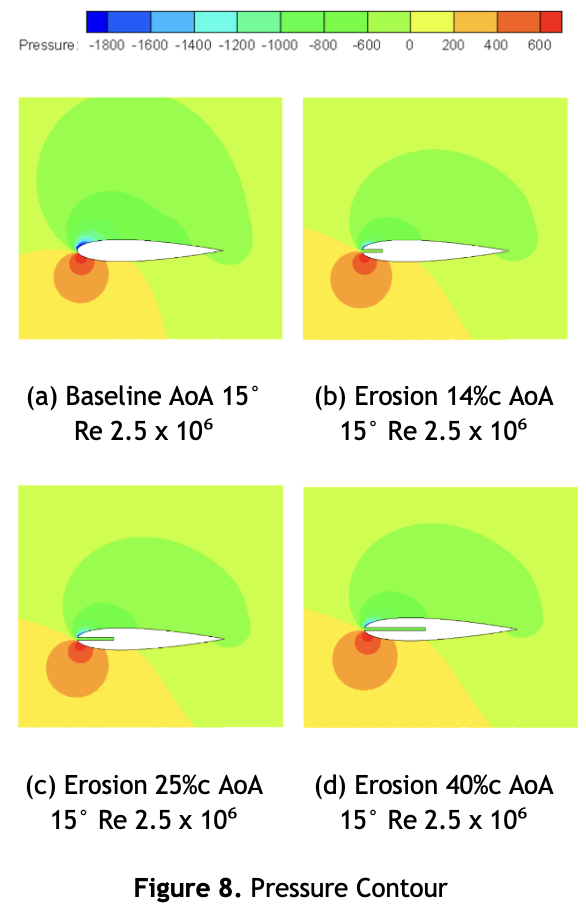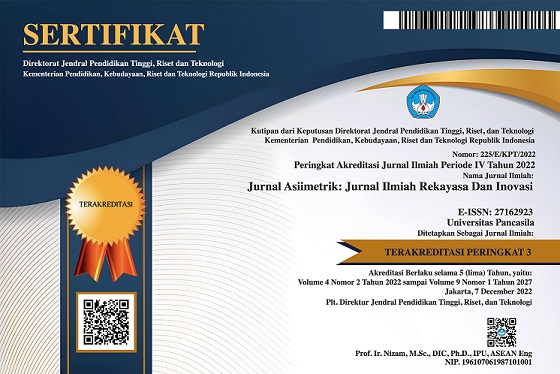Numerical Modelling of NACA 0015 Airfoil Under the Erosion Condition
Abstract views: 282 | pdf downloads: 265
Abstract
Airfoil that experiences erosion caused by flying debris that hit the airfoil can affect the performance of the airfoil. This research was studied to determine the effect of erosion with varying erosion length using numerical methods on the performance of the NACA 0015 airfoil. This research was simulated using the Computational Fluid Dynamics (CFD) approach. Reynolds Averaged Navier-Stokes (RANS) is implemented as the governing equation. The turbulence model used in this research is the k-epsilon model. The Reynolds number used is 1.5 x 10⁶. This research proves that the erosion effect can reduce the Cl value and increase the Cd value on the NACA 0015 airfoil. Increasing the erosion length on the airfoil can also affect the Cl value and Cd value, but this effect is insignificant. In the contour visualization, it can be seen that the airfoil that is experiencing erosion has a pressure contour that increases in the upper chamber and decreases in the lower chamber compared to the airfoil that does not experience erosion so that it can reduce the lifting force of the NACA 0015 airfoil. The flow velocity and streamline contours also show greater circulation in the erosion airfoil, which can accelerate the stall by 1o AoA. Then, variations in increasing erosion length on the airfoil do not show any significant differences in pressure contours or circulating flow.
Downloads
References
Aftab, S.M.A. and Ahmad, K.A. (2017) ‘CFD study on NACA 4415 airfoil implementing spherical and sinusoidal Tubercle Leading Edge’, PLOS ONE, 12(8), p. e0183456. A
Aziz, P.D.A. et al. (2014) ‘A simulation study on airfoils using VAWT design for low wind speed application’, in 2014 4th International Conference on Engineering Technology and Technopreneuship (ICE2T). 2014 4th International Conference on Engineering Technology and Technopreneuship (ICE2T), pp. 105–109.
Chen, X. et al. (2022) ‘An Improved Structured Mesh Generation Method Based on Physics-informed Neural Networks’. arXiv.
Darbandi, M. et al. (2006) ‘Modification of the Standard k-epsilon Turbulence Model for Multi-Element Airfoil Application Using Optimization Technique’, in 24th AIAA Applied Aerodynamics Conference. American Institute of Aeronautics and Astronautics (Fluid Dynamics and Co-located Conferences). pp. 1-12.
Gharali, K. and Johnson, D.A. (2012) ‘Numerical modeling of an S809 airfoil under dynamic stall, erosion and high reduced frequencies’, Applied Energy, 93, pp. 45–52.
Julian, J., Iskandar, W., Wahyuni, F. and Ferdyanto, F. (2022) ‘Computational Fluid Dynamics Analysis Based On The Fluid Flow Separation Point On The Upper Side Of The Naca 0015 Airfoil With The Coefficient Of Friction’, Media Mesin: Majalah Teknik Mesin, 23(2), pp. 70–82.
Julian, J., Iskandar, W., Wahyuni, F., Armansyah, A., et al. (2022) ‘Effect of Single Slat and Double Slat on Aerodynamic Performance of NACA 4415’, International Journal of Marine Engineering Innovation and Research, 7(2), pp. 93-100.
Julian, J., Iskandar, W. and Wahyuni, F. (2022) ‘Aerodynamics Improvement of NACA 0015 by Using Co-Flow Jet’, International Journal of Marine Engineering Innovation and Research, 7(4), pp. 284-291.
Kekina, P. and Suvanjumrat, C. (2017) ‘A Comparative Study on Turbulence Models for Simulation of Flow Past NACA 0015 Airfoil Using OpenFOAM’, MATEC Web of Conferences, 95, p. 12005.
Li, D. et al. (2018) ‘Effects of the particle Stokes number on wind turbine airfoil erosion’, Applied Mathematics and Mechanics, 39(5), pp. 639–652.
Loutun, M.J.T. et al. (2021) ‘2D CFD Simulation Study on the Performance of Various NACA Airfoils’, CFD Letters, 13(4), pp. 38–50.
Omer, A.M. (2008) ‘Green energies and the environment’, Renewable and Sustainable Energy Reviews, 12(7), pp. 1789–1821.
Roache, P.J. (1994) ‘Perspective: A Method for Uniform Reporting of Grid Refinement Studies’, Journal of Fluids Engineering, 116(3), pp. 405–413.
Sack, J.-R. and Urrutia, J. (2000) Handbook of Computational Geometry. North Holland: Elsevier. [Print].
Sun, J. et al. (2023) ‘Influence of blade maximum thickness on airfoil performance with varied leading edge erosion rate’, Frontiers in Energy Research, 10, pp. 1–15.
Wagner, H.-J. and Mathur, J. (2012) Introduction to Wind Energy Systems: Basics, Technology and Operation. 1st edn. Berlin: Springer Berlin, Heidelberg. [Print].
Wang, Y., Hu, R. and Zheng, X. (2017) ‘Aerodynamic Analysis of an Airfoil With Leading Edge Pitting Erosion’, Journal of Solar Energy Engineering, 139(061002), pp. 1–11.


























